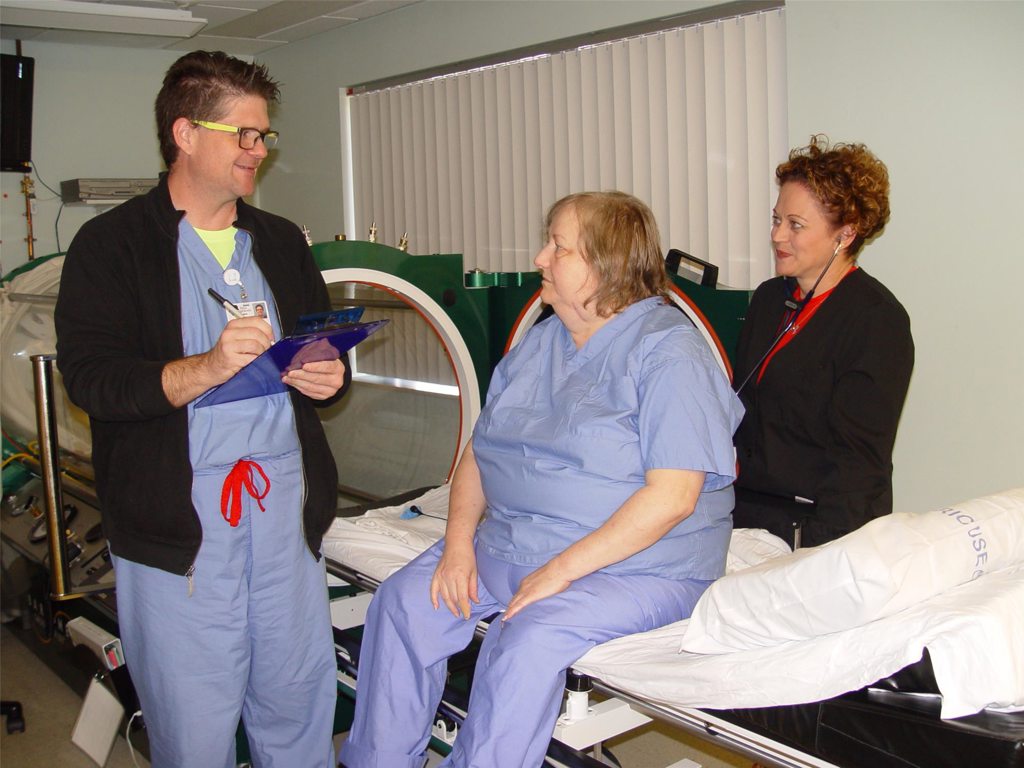
Hyperbaric Oxygen Therapy helps wound healing
Delores Wardrop of Summerville fell three years ago and broke her fibula. It was repaired with a plate and seven screws. She had no problems, and it healed. Life was good.
This summer, her leg and ankle felt stiff. She thought she sprained it, but a week later, it was limp.
A trip to the Emergency Department at Penn Highlands Brookville showed that her white blood count was up and she was dehydrated. She had an infection. Her skin around her ankle was turning dark.
Wardrop was admitted to Penn Highlands DuBois on July 22, and by July 24, her skin was blistering. An operation was needed to determine the severity of her infection of her lower-leg up, and it revealed just how bad the infection was. Her body was rejecting the titanium hardware that had been used to repair her fibula bone.
The hardware was removed, and Wardrop was on the road to recovery. This time,the wound needed to heal from the inside out and it started 3 centimeters deep at the bone.
Wardrop was admitted to the DuBois Nursing Home for care. She was not allowed to put weight on the leg that was operated on, and her good leg was hurting, too, because she had been relying on it.
To help, a referral was made to Dr. Tuesdae Stainbrook at The Wound Center at PH DuBois, a part of Penn Highlands Healthcare. She recommended hyperbaric oxygen therapy, or HBO therapy for short, to help her wound heal.
Hyperbaric oxygen therapy is performed using a total body, pressure chamber where the patient breathes 100 percent oxygen to increase the amount of oxygen in the blood, according to Brian Simpson, registered respiratory therapist and certified hyperbaric technologist. He and Alison Newara, a certified hyperbaric registered nurse, treat and monitor patients receiving HBO therapy at The Wound Center.
The air pressure inside a hyperbaric oxygen chamber is about two and a half times higher than the normal pressure in the atmosphere. This helps the blood carry more oxygen to organs and tissues in the body to help wounds, especially infected wounds, heal more quickly.
The therapy may be used to treat air or gas embolism, bone infections that have not improved with other treatments, burns, carbon monoxide poisoning, certain types of brain or sinus infections, decompression sickness, soft tissue infections, radiation injury, skin grafts and wounds that have not healed with other treatments. Many people with diabetes with foot wounds often get help with HBO therapy.
There are guidelines and criteria that must be met prior to beginning HBO therapy. Some health issues, such as having a pacemaker, might preclude people from the therapy. Simpson and Newara screen each patient for their health history.
Coming to the HBO unit, Wardrop’s wound started healing “in no time,” she said. “It’s been a really good thing.”
Wardrop has been through 40 sessions. Each session lasts about an hour and 50 minutes.
It takes approximately ten minutes for the chamber to reach the prescribed pressure. Once pressure is reached, the patient is at that pressure for the prescribed time. Then, it takes another ten minutes to bring the chamber back to normal atmospheric pressure.
The chamber – a very large, glass tube - didn’t make Wardrop feel claustrophobic, either. She said the machine is clear and it has a mirror so patients can see the side and the rest of the room. She can breathe easy in it, she said.
The patients are comfortable. They wear scrubs provided by the hospital, and there is a television to watch. Some people even like to sleep, Simpson said.
Like most pressure changes, such as being in an airplane, the ears can be sensitive to popping. Swallowing helps, and patients receive a water bottle to help them swallow during the “dive” to new pressures or “rise” back to normal. Patients with diabetes will also be given juice just in case their sugar-levels drop.
Now, Wardrop is at home, her wound is healing, and with physical therapy, the muscle shape in her leg is coming back.
“For wounds, pressure sores, people could highly benefit from it (HBO),” she said. “I did.”
For more information about HBO, call 814-371-4320. HBO isn’t just for patients of Penn Highlands DuBois. Patients from throughout the Penn Highlands Healthcare system and beyond may be referred here.
